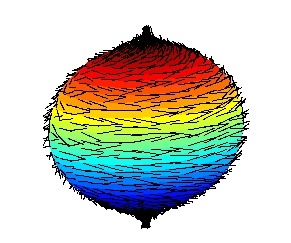|
Cowlick
A cowlick is a section of human hair that stands straight up or lies at an angle at odds with the style in which the rest of an individual's hair is worn. The most common site of a human cowlick is in the crown, but they can show up anywhere. They also sometimes appear in the front and back of the head. The term "cowlick" dates from the late 16th century, when physician Richard Haydock used it in his translation of Gian Paolo Lomazzo: "The lockes or plaine feakes of haire called cow-lickes, are made turning upwards." Management For people who are more concerned about cowlick management, more drastic measures may be used. Electrology, waxing, and even cosmetic surgery can be used to permanently correct the cowlick. See also * Ahoge *Hair whorl A hair whorl is a patch of hair growing in a circular direction around a visible center point. Hair whorls occur in most hairy animals, on the body as well as on the head. Hair whorls, also known as crowns, swirls, or trichoglyphs, c ... [...More Info...] [...Related Items...] OR: [Wikipedia] [Google] [Baidu] |
Hairy Ball Theorem
The hairy ball theorem of algebraic topology (sometimes called the hedgehog theorem in Europe) states that there is no nonvanishing continuous tangent vector field on even-dimensional ''n''-spheres. For the ordinary sphere, or 2‑sphere, if ''f'' is a continuous function that assigns a vector in R3 to every point ''p'' on a sphere such that ''f''(''p'') is always tangent to the sphere at ''p'', then there is at least one pole, a point where the field vanishes (a ''p'' such that ''f''(''p'') = 0). The theorem was first proved by Henri Poincaré for the 2-sphere in 1885, and extended to higher dimensions in 1912 by Luitzen Egbertus Jan Brouwer. The theorem has been expressed colloquially as "you can't comb a hairy ball flat without creating a cowlick" or "you can't comb the hair on a coconut". Counting zeros Every zero of a vector field has a (non-zero) "index", and it can be shown that the sum of all of the indices at all of the zeros must be two, because the Euler c ... [...More Info...] [...Related Items...] OR: [Wikipedia] [Google] [Baidu] |
Hair
Hair is a protein filament that grows from follicles found in the dermis. Hair is one of the defining characteristics of mammals. The human body, apart from areas of glabrous skin, is covered in follicles which produce thick terminal and fine vellus hair. Most common interest in hair is focused on hair growth, hair types, and hair care, but hair is also an important biomaterial primarily composed of protein, notably alpha-keratin. Attitudes towards different forms of hair, such as hairstyles and hair removal, vary widely across different cultures and historical periods, but it is often used to indicate a person's personal beliefs or social position, such as their age, sex, or religion. Overview The word "hair" usually refers to two distinct structures: #the part beneath the skin, called the hair follicle, or, when pulled from the skin, the bulb or root. This organ is located in the dermis and maintains stem cells, which not only re-grow the hair after it falls ou ... [...More Info...] [...Related Items...] OR: [Wikipedia] [Google] [Baidu] |
Richard Haydock
Richard is a male given name. It originates, via Old French, from Old Frankish and is a compound of the words descending from Proto-Germanic ''*rīk-'' 'ruler, leader, king' and ''*hardu-'' 'strong, brave, hardy', and it therefore means 'strong in rule'. Nicknames include "Richie", "Dick", " Dickon", " Dickie", "Rich", "Rick", "Rico", "Ricky", and more. Richard is a common English, German and French male name. It's also used in many more languages, particularly Germanic, such as Norwegian, Danish, Swedish, Icelandic, and Dutch, as well as other languages including Irish, Scottish, Welsh and Finnish. Richard is cognate with variants of the name in other European languages, such as the Swedish "Rickard", the Catalan "Ricard" and the Italian "Riccardo", among others (see comprehensive variant list below). People named Richard Multiple people with the same name * Richard Andersen (other) * Richard Anderson (other) * Richard Cartwright (other) * R ... [...More Info...] [...Related Items...] OR: [Wikipedia] [Google] [Baidu] |
Gian Paolo Lomazzo
Gian Paolo Lomazzo (26 April 1538 – 27 January 1592; his first name is sometimes also given as "Giovan" or "Giovanni") was an Italian artist and writer on art. Praised as a painter, Lomazzo wrote about artistic practice and art theory after blindness compelled him to pursue a different professional path by 1571. Lomazzo's written works were especially influential to second generation Mannerism in Italian art and architecture. Early life Gian Paolo Lomazzo was born in Milan from a family who had emigrated from the town of Lomazzo. His early training was with Giovan Battista della Cerva in Milan. He painted a large ''Allegory of the Lenten Feast'' for ''San Agostino'' in Piacenza (1567). Other works by his hand include an elaborate dome with ''Glory of Angels'' for the Capella Foppa in San Marco in Milan, and the ''Fall of Simon Magus'' in the wall of the chapel. Lomazzo was depicted on a ca. 1560 medal by Annibale Fontana that described him as having been introduced by ... [...More Info...] [...Related Items...] OR: [Wikipedia] [Google] [Baidu] |
Electrology
Electrology is the practice of electrical hair removal to permanently remove human hair from the body. Electrolysis is the actual process of removing hair using electricity. In electrolysis, a qualified professional called an electrologist slides a hair-thin, solid metal probe into each hair follicle without puncturing the skin (when inserted properly). Electricity is delivered to the follicle through the probe, which causes localized damage to the areas that generate hairs, either through the formation of caustic sodium hydroxide (the galvanic method), overheating ( thermolysis), or both (the blend method). Methods All three methods (galvanic, thermolysis, and blend) have their own merits, and one method is not better than another. The success depends on the skill of the electrologist, the type of hair being removed, the condition of the skin and the pain threshold of the client. All three methods, when properly performed, can be thorough at destroying the hair matrix cells, an ... [...More Info...] [...Related Items...] OR: [Wikipedia] [Google] [Baidu] |
Waxing
Waxing is the process of hair removal from the root by using a covering of a sticky substance, such as wax, to adhere to body hair, and then removing this covering and pulling out the hair from the follicle. New hair will not grow back in the previously waxed area for four to six weeks, although some people will start to see regrowth in only a week due to some of their hair being on a different human hair growth cycle. Almost any area of the body can be waxed, including eyebrows, face, pubic hair (called bikini waxing or intimate waxing), legs, arms, back, abdomen, chest, knuckles, and feet. There are many types of waxing suitable for removing unwanted hair. Types Strip waxing (soft wax) is accomplished by spreading a wax thinly over the skin. A cloth or paper strip is applied and pressed firmly, adhering the strip to the wax and the wax to the skin. The strip is then quickly ripped against the direction of hair growth, as parallel as possible to the skin to avoid trauma to t ... [...More Info...] [...Related Items...] OR: [Wikipedia] [Google] [Baidu] |
Cosmetic Surgery
Plastic surgery is a surgical specialty involving the restoration, reconstruction or alteration of the human body. It can be divided into two main categories: reconstructive surgery and cosmetic surgery. Reconstructive surgery includes craniofacial surgery, hand surgery, microsurgery, and the treatment of burns. While reconstructive surgery aims to reconstruct a part of the body or improve its functioning, cosmetic (or aesthetic) surgery aims at improving the appearance of it. Etymology The word ''plastic'' in ''plastic surgery'' means "reshaping" and comes from the Greek πλαστική (τέχνη), ''plastikē'' (''tekhnē''), "the art of modelling" of malleable flesh. This meaning in English is seen as early as 1598. The surgical definition of "plastic" first appeared in 1839, preceding the modern "engineering material made from petroleum" sense by 70 years. History Treatments for the plastic repair of a broken nose are first mentioned in the Egyptian medical tex ... [...More Info...] [...Related Items...] OR: [Wikipedia] [Google] [Baidu] |
Ahoge
The following is a glossary of terms that are specific to anime and manga. Anime includes animated series, films and videos, while manga includes graphic novels, drawings and related artwork. ''Note: Japanese words that are used in general (e.g. ''oniisan'', ''kawaii'' and '' senpai'') are not included on this list, unless a description with a reference for notability can be provided that shows how they relate.'' Character traits * : Refers to any noticeable strand of hair which sticks in a different direction from the rest of an anime/manga character’s hair. * : Beautiful young woman. * : Japanese aesthetic concept of the ideally beautiful young man: androgynous, effeminate or gender-ambiguous. In Japan, it refers to youth with such characteristics, while in Europe and the Americas, it has become a generic term for attractively androgynous males of all ages. * : typically used to describe early teens who have delusions of grandeur and have convinced themselves they have hi ... [...More Info...] [...Related Items...] OR: [Wikipedia] [Google] [Baidu] |
Hair Whorl
A hair whorl is a patch of hair growing in a circular direction around a visible center point. Hair whorls occur in most hairy animals, on the body as well as on the head. Hair whorls, also known as crowns, swirls, or trichoglyphs, can be either clockwise or counterclockwise in direction of growth. In human theories Hair whorls on the head ( parietal whorls) have been studied by some behaviorists. Most people have clockwise scalp hair-whorls. Parietal whorls which are considered to be normal scalp patterns could be a single whorl or double whorls. Cases of triple parietal whorls are less common. Amar J. S. Klar conducted research to see if there was a genetic link between handedness In human biology, handedness is an individual's preferential use of one hand, known as the dominant hand, due to it being stronger, faster or more Fine motor skill, dextrous. The other hand, comparatively often the weaker, less dextrous or sim ... and hair-whorl direction. He found that 8.4% o ... [...More Info...] [...Related Items...] OR: [Wikipedia] [Google] [Baidu] |





